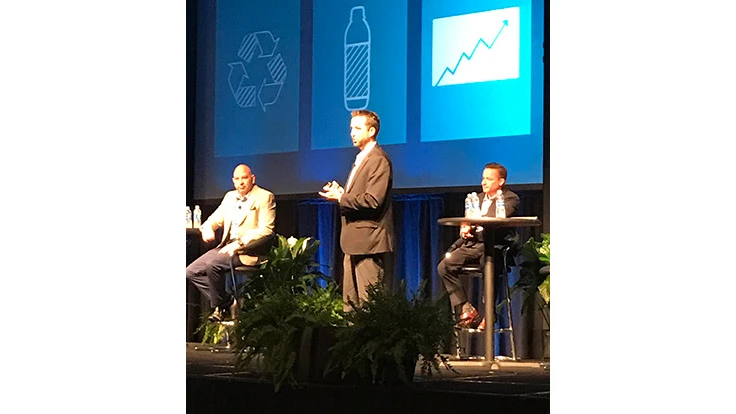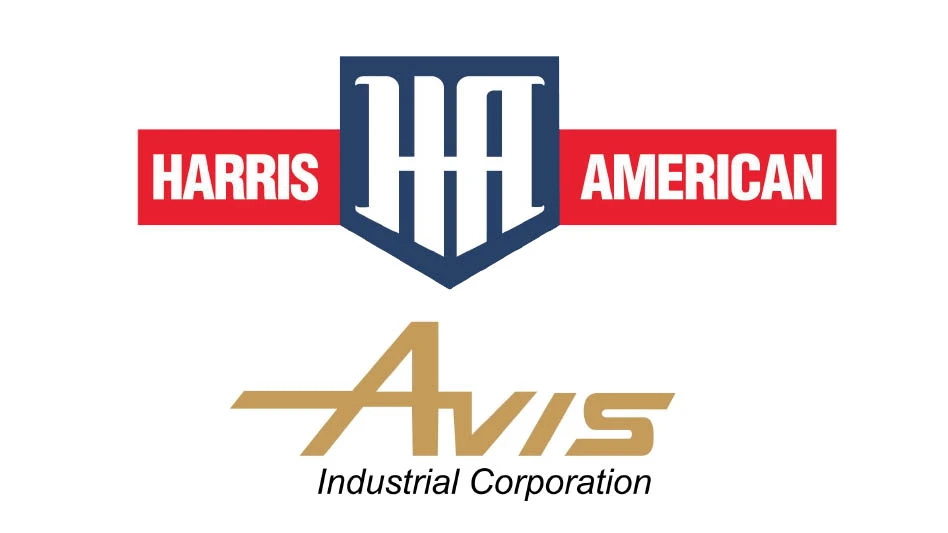
Pictured above, from left: Rick Perez of Avangard Innovative, Zach Freeze of Wal-Mart
and Stephen Sikra of Procter & Gamble.
Circular economy and sustainable materials management (SMM) are buzzwords that have gained popularity recently; but, as one speaker at Plastics Recycling 2017 said, both concepts have the same goal: creating a reliable supply chain that incorporates recyclables.
Nina Goodrich of GreenBlue and the Sustainable Packaging Coalition (SPC), Charlottesville, Virginia, said SMM and the circular economy, two approaches to using and reusing materials more productively over their lives, had more similarities than differences. She added that both approaches are concerned with creating a “reliable supply chain from waste.” Goodrich and the other speakers during the session stressed that this would need to be a collaborative process if it was going to be successful.
The opening plenary session at Plastics Recycling 2017, hosted by Resource Recycling, Portland, Oregon, at the Hyatt Regency New Orleans March 6-8, looked at how these concepts are shaping sustainability initiatives that brand owners and retailers are championing.
To assist with realizing the goal of incorporating recyclables into the supply chain , the SPC joined with The Recycling Partnership, Falls Church, Virginia, to form Applying Systems Thinking to Recycling (ASTRX). The partners say ASTRX combines the expertise of both organizations to build a roadmap for strengthening the American recycling industry through collaboration. The goal of ASTRX and its founding partners is “to create robust confidence in the recycling system so people will invest in recycled content,” Goodrich siad.
The recycling system comprises five elements, she said: end markets, reprocessing, sorting, collection and consumer engagement.
The SPC’s How2Recycle Label, a standardized labeling system designed to clearly communicate recycling instructions to the public, can help to address the issue of collection. Additionally, Goodrich said SPC recently introduced a new online platform for How2Recycle that automates the process of working with the organization to use the label.
Goodrich says the label helps brand owners “distinguish between lookalikes in packaging” and helps municipalities “eliminate wishful recycling.”
She said the new How2Recycle Label platform would enable packaging recyclability to be tracked and would provide brand owners with additional tools to improve packaging recyclability.
Goodrich added that packaging design and collection must be linked to realize the goals of SMM and the circular economy.
Rick Perez, president of waste optimization company Avangard Innovative, Houston, discussed his company’s approach to maximizing the volume and value of recyclables from the clients it serves through its Natura Zero program.
“The circular economy is the right thing to do,” he said, adding that the concept focuses on using the least amount of resources and generating the least amount of waste in creating a product, as well as on recapturing that product at the end of its life.
Perez said AI’s goal is to minimize the amount of material going to the landfill, so the company often works backward from that goal to find solutions for difficult-to-recycle materials generated by its clients. “There has to be an answer,” Perez said when it came to challenging materials. However, he added that solutions need to make sense environmentally, economically and socially.
Recycled products often can be viewed as inferior to prime products, Perez said, adding, “We need to change the way we think of recycled content.” To do this, he said, facts and data are necessary. “To sustain plastics recycling, we must use technology and collaborate throughout the supply chain.”
Stephen Sikra, who is responsible for the development of people, packages and processes at Procter & Gamble Co. (P&G), Cincinnati, said his company’s goals are to use 20 percent less material in its packaging and to double its use of recycled resin in packaging. “We want your PCR (postconsumer recycled resin),” he told attendees.
Sikra added the P&G recognizes that it has a role to play in recycling by designing packaging for recycling, inspiring consumers to recycle, advancing recycling infrastructure and creating demand for PCR.
When it comes to investing in recycling infrastructure, the company is working with the Closed Loop Fund and The Recycling Partnership, he said. Other recycling-related collaborations P&G is involved in include the How2Recycle Label, Materials Recovery for the Future and TerraCycle.
P&G funds recycling programs managed by TerraCycle for packaging that cannot be recycled via curbside programs, Skira said. “TerraCycle is a bridging program until curbside recycling is available for packages that offer better overall sustainability but may not be recyclable at the curbside.”
One of collaborations between P&G and TerraCycle will use plastics collected at beaches to produce the bottles for Head & Shoulders. The bottles will be made from up to 25 percent recycled beach plastic.
P&G, in partnership with TerraCycle and Suez Environnement, based in Paris, will begin the recycling program in France by the middle of this year, producing a limited-edition shampoo bottle. The shampoo will be sold through the retailer Carrefour.
Sponsored Content
Still relying on manual sorters?
Let AI do the heavy lifting. Waste Robotics delivers reliable, high-performance robots tailored for complex waste streams. They require minimal maintenance, are easy to operate, and are designed to boost your recovery rates. Smarter sorting starts with the right partner. Waste Expo Booth #1969 & REMA #2843
Click here to see our robots in action!Regarding P&G’s commitment to using recycled PCR, Sikra said the company has done so for 28 years. In 2015-16, P&G used 34,000 tons of PCR annually and is working up to using 52,000 tons annually. He added that the company uses recycled plastics in good times and in bad, though it may sometime sandwich that content between virgin resin to get the look and performance required for a package. However, he added that a consistent commitment to using PCR allows the company to get the best price possible for the material.
Skira said supply of and demand for PCR must be balanced in “an open-minded way,” which would require “innovation and responsibility across the entire value chain.”
Wal-Mart’s Zach Freeze, senior director of strategic initiatives, sustainability, said the company began its sustainability journey in 2005 after Hurricane Katrina. Its goals are to achieve zero waste, use 100 percent renewable energy (Wal-Mart currently is using 84 percent renewable energy.) and sell products that sustain people and the environment, he added.
The company has shifted its thinking away from waste diversion to value creation, Freeze said, and does so in four areas: working with suppliers on package design, improving recovery of materials within its operations, using customer-friendly labeling and support of the Closed Loop Fund through the Wal-Mart Foundation.
Wal-Mart introduced its Packaging Playbook in October of 2016. Freeze said sustainable packaging focuses on optimizing design, using the right amount of packaging and the least amount of material possible. Additionally, Wal-Mart seeks to source sustainably by using recycled or renewable content and to support recycling by designing for recyclability and communicating recyclability.
By 2025, he said, Wal-Mart wants to use 100 percent recyclable packaging for its private label brands.
Freeze said in addition to the environmental benefits of using PCR content in packaging, doing so can offer more price stability when virgin pricing increases.
Plastics Recycling 2017 was March 6-8 in New Orleans.
Get curated news on YOUR industry.
Enter your email to receive our newsletters.
Latest from Recycling Today
- Enfinite forms Hazardous & Specialty Waste Management Council
- Combined DRS, EPR legislation introduced in Rhode Island
- Eureka Recycling starts up newly upgraded MRF
- Reconomy Close the Gap campaign highlights need for circularity
- Nickel carbonate added to Aqua Metals’ portfolio
- EuRIC, FEAD say End-Of-Life Vehicle Regulation presents opportunity for recyclers
- Recyclers likely to feel effects of US-China trade war
- BCMRC 2025 session preview: Navigating battery recycling legislation and regulations










